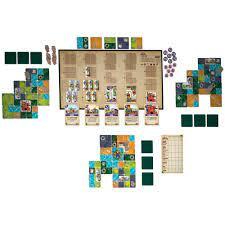Life in Reterra, a new board game by Eric Lang and published by Hasbro, is a perfect introduction to tile-laying games and combines simple and easy to understand gameplay with dozens of potential variation and fun strategies that should keep most games competitive. Released earlier this year, Life in Reterra on its surface seems like a bit of an odd duck – Hasbro’s main toy brand tends to publish simple, family-friendly games with barely any crossover with the growing field of deeper and more complex tabletop games. Additionally, the game’s award-winning designer Eric M. Lang is best known for creating very challenging and complex games himself, with games like Blood Rage and Rising Sun combining multiple mechanics and systems together. However, Life in Reterra succeeds by providing easy-to-understand rules, a fixed endgame condition and ways to either tone down or ramp up the complexity based on who is playing.
Videos by ComicBook.com
In Life in Reterra, players are tasked with rebuilding a community within a post-apocalyptic landscape of some kind. Players start with a single 2×2 tile that contains four different types of terrain. On their turn, they are tasked with expanding their private community by choosing either one tile from a group of five publicly available tiles or from a small pool of “private” tiles reserved for that player. Players must adhere to two simple rules – their community must eventually form a 4×4 square of tiles and the tile they place on their turn must fully match up with the edge of another tile.
In addition to containing one or more of five different terrain types, individual tiles in Life in Reterra may also contain one or more gear symbols or relic symbols, both of which translate to victory points in different ways. On the turn the tile is placed, a player may choose to place an inhabitant on a gear space on that tile. They can also choose to align gears on different tiles to form either a pair of gears, a 3-gear “L” shape, or a square of four gears. If players have one of those three gear patterns, they can freely place a building with the same corresponding shape on top of it. Each building has a built-in victory point amount and an ability that’s activated in different way. For instance, the farm clogs an opponent’s relics with junk tokens, while the garden rewards additional points if placed in a terrain group with exactly seven spaces in it.

A big chunk of the strategy in Life in Reterra comes from which buildings are chosen to be used for a particular game. The game comes with three “pre-built” sets of five buildings, but players are also encouraged to mix and match their own combinations. Each building also has two distinct abilities and victory point totals (indicated by a card placed on the building pool at the start of the game), which in essence gives players 30 different buildings to choose from.
At the end of the game, players score points based on how many large groupings of terrain they have, how many inhabitants they have, how many fully enclosed energy sources they have (energy sources are a distinct type of tile in the game), how many relics they have, and the types of buildings they have. They also lose points for having junk on their board.
What I enjoyed about Life in Reterra is that the game, at least on its surface, feels pretty balanced. There is a limited pool of buildings available to place in each game, but missing out on one or more building types isn’t necessarily a game-killer. In one game of Life in Reterra, I was able to quickly pivot when my opponent snatched up enough farms to ruin my chances of loading up my board with buildings that scored additional points for having more relics in my community. Likewise, while I was able to score the “big” building of the game when I grabbed the one four-gear building, my opponent kept the score close simply due to the number of junk tiles she had placed on my board.
I also enjoyed that there are countless combinations to Life in Reterra – just the three pre-built options AND the five suggestions in the rulebook should keep players very busy for the foreseeable future.
My biggest criticism of Life in Reterra was that the asphalt and jungle tiles had a similar enough hue that it was hard to tell the difference. Dark green and black do not go well together, especially when they are side by side. In our first couple of playthroughs, we had a couple of close calls where a player thought they were grabbing a tile heavy with asphalt only to discover it was jungle upon closer inspection. It’s a minor quibble, though, and one that can easily be fixed either with good lighting or making sure that a player knows what they’re putting down before they put it down.
Ultimately, this marks the second strong “introductory” board game released this year, alongside Ravensburger’s Mycella. Both are games that my 9-year old will enjoy and will likely master in just a few playthroughs, but it’s also challenging enough that I can put it on an adult gaming table and still get enjoyment for a quick 30-45 minute playthrough. I’m enjoying this new trend of games made with an eye towards introducing complex board game concepts while also not being too simplistic that they can’t be enjoyed.
Life in Reterra is available in stores now. A review copy was provided by Hasbro for review.








